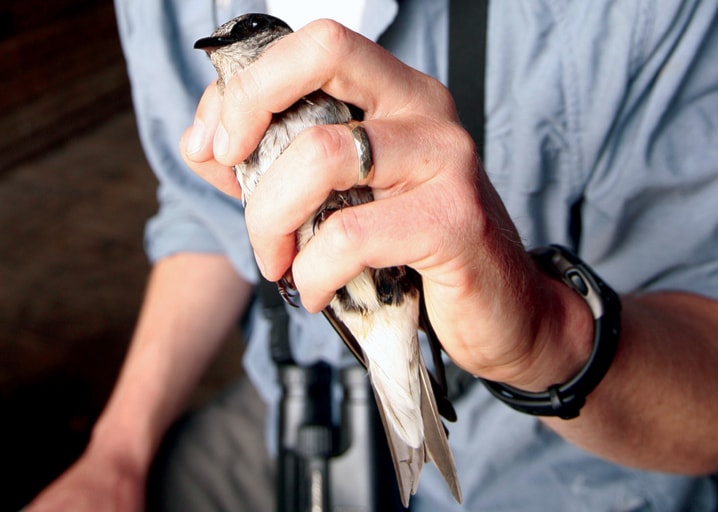Long ago, the purple martin would nest in the drinking gourds near the rivers in North America. Alerting villagers to the presence of mountain lions or crows that would interfere with the corn crops, the songbird would be music to the ears of villagers.
Today the beloved backyard summer swallow typically nests in man-made boxes shaped like gourds or apartment-style boxes in backyards of homes across Canada. At the Ellis Bird Farm, some 60 pairs of purple martins make their nests around mid to late April to late June to breed.
Fifteen of those purple martins were recently banded and selected to be part of a research project on migration patterns using a relatively new conservation tool.
Postdoctoral researcher Kevin Fraser, who studies migratory bird behaviour at York University in Toronto, attached a small light level geolocator on the backs of the birds on Wednesday and Thursday. The device will allow scientists to track the daily positions of the purple martins from the time they leave Ellis Bird Farm at the end of the breeding season to when they return next spring.
Fraser said researchers have always been able to track larger birds like the albatross for a long time by placing a satellite tag on the birds.
With the use of this relatively new device, researchers are learning things about the migration behaviours that were impossible until now.
“Most birds are small,” said Fraser. “And most birds are songbirds in the world. So there’s this whole area of migration behaviour that we knew nothing about in the world. So there’s this huge area of migration behaviour that we knew nothing about until we started placing these small devices on the backs.”
The tiny device weighs about one gram, less than five per cent of the bird’s weight. Few research projects in the world use the small device for research but Fraser said the tool is gaining popularity. The tool will allow researchers to learn about migration routes, speed, times and wintering areas.
In 2007, researchers at York University under Dr. Brigit Stutchbury first used the device on purple martins and wood thrushes. They were able to track the birds’ migration to South American and return to North America.
Fraser said the research has lead them to believe that purple martins are not flexible in their migratory behaviours.
“They are running these little genetic programs that tell them when to go, how far to go, how fast to fly and where to end up at a certain time,” said Fraser. “They are not necessary flexible to changing weather conditions, particularly with climate change.”
Since purple martins are reliant on aerial insects like dragonflies or damsel flies for a food source, Fraser said an early spring might cause havoc on the swallow’s food source and ultimately breeding.
“If the martins are running this little genetic program that tells them when to arrive and depart from the Amazon, they can’t really respond to weather conditions en route or on the breeding sites,” said Fraser. “Then they are going to end up arriving after the peak. They won’t do as well breeding wise. We think that’s why the populations might be going down. We don’t have any data to show that yet.”
Fraser said it’s a theory that has been shown in European birds that migrate between Africa and Europe where birds have arrived after the peak of food and not have adjusted migratory schedules. Fraser said purple martins are consistent in what they do timing wise and it’s important they track the different populations.
As part of his Alberta project, Fraser will also attach geolocators to purple martins in Camrose.
The Alberta purple martin colonies are at the northern-most limit of the purple martin breeding range. This makes them particularly interesting to scientists, says Fraser, because the most northern populations of the purple martins have declined in the last few decades.
“We don’t really know why,” said Fraser. “Which is one of the reasons why we are tracking them.”
Fraser said the Alberta martins will likely have the highest migration distance than any purple martins anywhere. Purple martins are North America’s largest species of swallow. They winter in South America and head north every spring to breed simply because of the abundance of insectivorous food supply. In Alberta, purple martins are most common in aspen parkland, north to the Lesser Slave Lake and Cold Lake areas and across to the Peace River Parklands.
Next year when the martins return, the geolocators will be removed and sent to York University where they will analyze the data.
Purple martins have flocked to the Ellis Bird Farm since 1999 when Del and Debra McKinnon, co-founders of the Purple Martin Conservancy in Pigeon Lake, set the farm up to attract the martins to the site. In recent years, the number of pairs returning to the Ellis Bird Farm have fluctuated between 40 and 60 pairs. The PMC has overseen the development of a special purple martin condo called “The Ellis Condo” at the farm.
“(Ellis Bird Farm) went about 18 years without martins,” said Del McKinnon. “They weren’t doing things just right for the birds. We know what they like and don’t like. Once we set them up, they will get martins.”
For information on the Purple Martin Conservancy, phone 780-389-2220 or dmckinon@telusplanet.net and the Ellis Bird Farm visit www.ellisbirdfarm.ab.ca.
crhyno@reddeeradvocate.om
